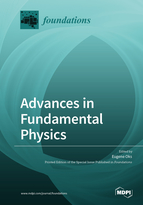Advances in Fundamental Physics
A special issue of Foundations (ISSN 2673-9321). This special issue belongs to the section "Physical Sciences".
Deadline for manuscript submissions: closed (31 July 2022) | Viewed by 70750
Special Issue Editor
Interests: atomic and molecular physics; astrophysics; plasma physics
Special Issues, Collections and Topics in MDPI journals
Special Issue Information
Dear Colleagues,
This Special Issue celebrates the opening of a new section of the journal Foundation: Physical Sciences. We invite theoretical and experimental studies related to all areas of fundamental physics. We welcome reviews and regular research papers without imposing any restrictions on the length of the paper. We also welcome short communications. These are expected to contain a preliminary presentation of interesting, potentially important ideas. Papers submitted before 1 January 2022 would be published free of charge (if accepted).
Best,
Prof. Dr. Eugene Oks
Guest Editor
Manuscript Submission Information
Manuscripts should be submitted online at www.mdpi.com by registering and logging in to this website. Once you are registered, click here to go to the submission form. Manuscripts can be submitted until the deadline. All submissions that pass pre-check are peer-reviewed. Accepted papers will be published continuously in the journal (as soon as accepted) and will be listed together on the special issue website. Research articles, review articles as well as short communications are invited. For planned papers, a title and short abstract (about 100 words) can be sent to the Editorial Office for announcement on this website.
Submitted manuscripts should not have been published previously, nor be under consideration for publication elsewhere (except conference proceedings papers). All manuscripts are thoroughly refereed through a single-blind peer-review process. A guide for authors and other relevant information for submission of manuscripts is available on the Instructions for Authors page. Foundations is an international peer-reviewed open access quarterly journal published by MDPI.
Please visit the Instructions for Authors page before submitting a manuscript. The Article Processing Charge (APC) for publication in this open access journal is 1000 CHF (Swiss Francs). Submitted papers should be well formatted and use good English. Authors may use MDPI's English editing service prior to publication or during author revisions.
Keywords
- Classical mechanics
- Quantum mechanics
- Atomic, molecular, and optical physics
- Physics of plasmas and gases (including plasma spectroscopy)
- Astronomy and astrophysics (including cosmology)
- Condensed matter physics
- Nuclear physics
- Physics of elementary particles and fields
- Interdisciplinary physics




